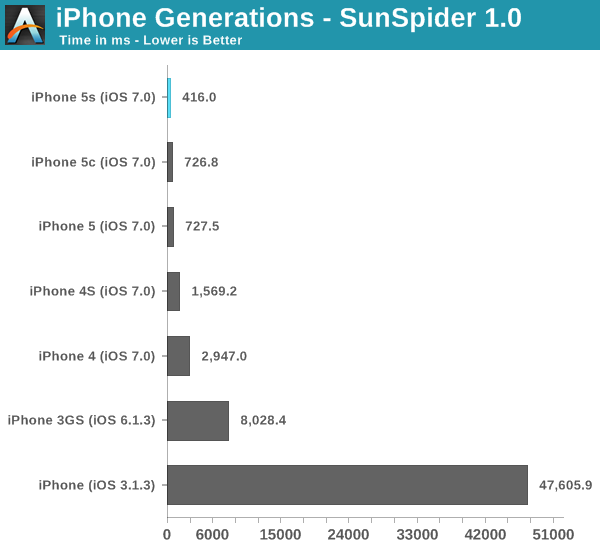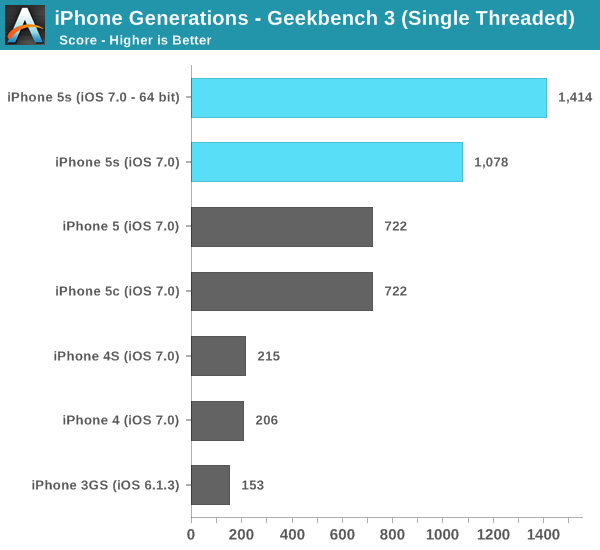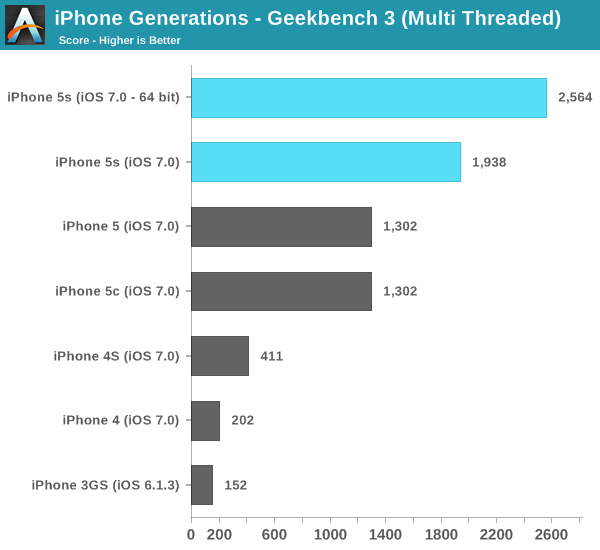The iPhone 5s Review
by Anand Lal Shimpi on September 17, 2013 9:01 PM EST- Posted in
- Smartphones
- Apple
- Mobile
- iPhone
- iPhone 5S
iPhone Performance Across Generations

Performance improved by a factor of 100x compared to the original iPhone. You can cut that in half if the iPhone could run iOS 4. Needless to say, Apple's CPU performance estimates aren't unreasonable. We've come a long way since the days when ARM11 cores were good enough.
Even compared to a relatively modern phone like the iPhone 4, the jump to a 5s is huge. The gap isn't quite at the level of an order of magnitude, but it's quickly approaching it. Using the single core iPhone 4 under iOS 7 just feels incredibly slow. Starting with the 4S things get a lot better, but I'd say the iPhone 4 is at the point now where it's starting to feel too slow even for normal consumers (at least with iOS 7 installed).

Browsermark 2.0 gives us a good indication of less CPU bound performance gains. Here we see over a 5x increase in performance compared to the original iPhone, and an 83% increase compared to the iPhone 4.
I wanted to have a closer look at raw CPU performance so I turned to Geekbench 3. Unfortunately Geekbench 3 won't run on anything older than iOS 6, so the original iPhone bows out of this test.

Single threaded performance scaled by roughly 9x from the 3GS to the iPhone 5s. The improvement since the iPhone 4/4S days is around 6.5x. Single threaded performance often influences snappiness and UI speed/feel, so it's definitely an important vector to scale across.

Take into account multithreaded performance and the increase over the 3GS is even bigger, almost 17x now.
The only 3D test I could get to reliably run across all of the platforms (outside the original iPhone) was Basemark X. Again I had issues getting Basemark X running in offscreen mode on iOS 7 so all of the tests here are run at each device's native resolution. In the case of the 3GS to 4 transition, that means a performance regression as the 3GS had a much lower display resolution to deal with.

Apple has scaled GPU performance pretty much in line with CPU performance over the years. The 5s scores 15x the frame rate of the iPhone 4, at a higher resolution too.
iPhone 5s vs. Bay Trail
I couldn't help but run Intel's current favorite mobile benchmark on the iPhone 5s. WebXPRT by Principled Technologies is a collection of browser based benchmarks that use HTML5 and js to simulate a number of workloads (photo editing, face detection, stocks dashboard and offline notes).

Granted we're comparing across platforms/browsers here, but the 5s as a platform does extremely well in Intel's favorite benchmark. The 5c by comparison performs a lot more like what we'd expect from a smartphone platform. The iPhone 5s is in a league of its own here. While I don't expect performance equalling the Atom Z3770 across the board, the fact that Apple is getting this close (with two fewer cores at that) is a testament to the work done in Cupertino.
At its launch event Apple claimed the A7 offered desktop class CPU performance. If it really is performance competitive with Bay Trail, I think that statement is a fair one to make. We're not talking about Haswell or even Ivy Bridge levels of desktop performance, but rather something close to mobile Core 2 Duo class. I've broken down the subtests in the table below:
| WebXPRT Performance (time in ms, lower is better) | ||||||
| Chrome/Mobile Safari | Photo Effects | Face Detection | Stocks | Offline Notes | ||
| Apple iPhone 5s (Apple A7 1.3GHz) | 878.9 ms | 1831.4 ms | 436.1 ms | 604.6 ms | ||
| Intel Bay Trail FFRD (Atom Z3770 1.46GHz) | 693.5 ms | 1557.0 ms | 542.9 ms | 737.3 ms | ||
| AMD A4-5000 (1.5GHz) | 411.2 ms | 2349.5 ms | 719.1 ms | 880.7 ms | ||
| Apple iPhone 5c (Apple A6 1.3GHz) | 1987.6 ms | 4119.6 ms | 763.6 ms | 1747.6 ms | ||
It's not a clean sweep for the iPhone 5s, but keep in mind that we are comparing to the best AMD and Intel have to offer in this space. I suspect part of why this is close is because both of those companies have been holding back a bit (there's no rush to build the fastest low margin parts), but it doesn't change reality.










464 Comments
View All Comments
lucian303 - Wednesday, September 18, 2013 - link
I'd hardly say browser benchmarks are indicative of actual CPU or overall performance considering the huge differences in browser implementations. It tests the speed of the browser on the hardware, not the hardware itself.Whitereflection - Wednesday, September 18, 2013 - link
Normally when people write cellphone reviews, They write things that most people can understand and comparing specs that are practical and features that people actually use and care about. Keep in mind most people have one or more smartphone nowadays, You don't need to be a rocket scientist to read a review. Sadly 50% of review is written in Mars language.tech01x - Wednesday, September 18, 2013 - link
You are free to read a lightweight review from any number of less competent reviewers. There are plenty on the net. Matter of fact, plenty of other reviewers are going to incorporate Anandtech's review as a fundamental part of their review.tredstone - Wednesday, September 18, 2013 - link
that's very true. in fact there are lots of reviews that incorporate parts or Anandtech's review. if people cannot make sense of the technical info they can always go and find a review that places more emphasis on the pretty coloursMikefromSA - Wednesday, September 18, 2013 - link
I'm interested in how it performs as a phone. Did I miss that section, or was it not a consideration?tecsi - Wednesday, September 18, 2013 - link
What are the implications of non-world Qualcomm chip for China Mobile?BSMonitor - Wednesday, September 18, 2013 - link
I want to know if your OG iPhone is in Mint condition! Some day that'll sell on eBay for $2M!hydreds - Wednesday, September 18, 2013 - link
Great review Thanks. Wish you had a video review. Not that I love to see you. I am lazy to read.webdev511 - Wednesday, September 18, 2013 - link
And of course as far as handsets go this is an iOS Android only party. While I'm sure Windows Phone 8 devices would probably score lower, they certainly don't feel that way when you're using one.apertotes - Wednesday, September 18, 2013 - link
"Now going back and holding an iPhone 4S, it feels like the very opposite is true - the 4S was too heavy"And that is why Apple can't loose. No matter what they did, the last thing they settle for its going to always be perfect. At least for most reviewers.
Of course, this does not mean that the nimble Galaxy S2 was right. No, at the time, it was wrong. Lightness is only good starting on iphone 5.